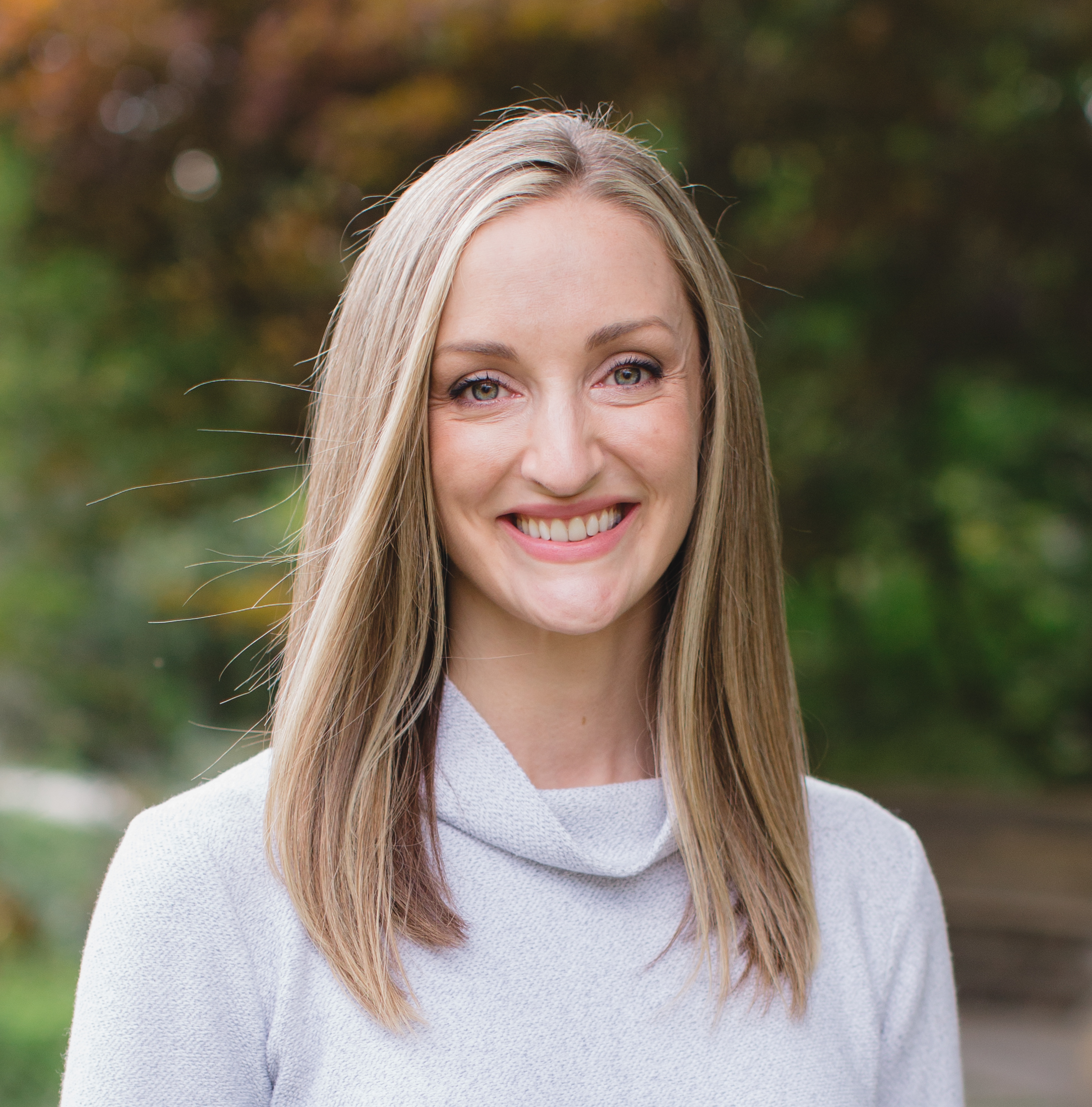B2B audiences, like all audiences, are comprised of humans. And humans are hard-wired for connection. That’s why we’re drawn to podcast and video content. It speaks to us at a human level.
While podcast and video content certainly isn’t new, it is still nuanced among brands — particularly B2B. Casted was founded in 2019, just as the wave of B2B podcast adoption was emerging. Many of our earliest conversations then ended in, “Yeah, I’m just not sure podcasts are really going to be a thing B2B brands do.” And today, with brands like Salesforce, Gong, Drift, and IBM doubling-down on their audio and video content — not only as a nice-to-have content channel, but as a central element of their thought leadership and overall brand and demand strategy — this wave we predicted is not only here, it’s quickly approaching tidal territory.
Over the last three years, Casted has been at the front of this wave, leading the conversation about B2B podcasting, as well as video, and the incredibly important — even foundational — role they play in the future of content marketing. We’ve been the vanguard in this movement, and it’s exciting to see it grow. But as it does, it’s really important that we acknowledge the various stages of the journey to greatness in this next generation of B2B content, which we’ve deemed Amplified Marketing.
To have this conversation, we need shared understanding, expectations, and vocabulary about the various stages of this journey. So we created the B2B Podcast Maturity Curve. It explains each stage a brand navigates as it experiments with audio and video content, creates a show, builds an audience, amplifies that content, and ultimately implements an amplified marketing strategy that delivers clear, measurable business value (i.e., actual revenue).
This visual representation of the five stages is further supported with explanations of nuances, contextual details, unique characteristics, and indicators of increasing maturity at each stage. We have summarized it all here to help marketers begin to understand what’s possible as they embrace the power of podcast and video content. Our hope is that it starts a conversation among all of us about where we are on the maturity curve today — collectively and as individual brands — and what we can do to advance and realize exponentially more value through creativity and connection.
We see and have worked with (or been a part of) brands at every stage of this curve, which provided the data and insights to create this post. We have helped hundreds of marketers at B2B companies escalate from stage to stage, and you can do it, too. Regardless of where you are on the curve today, you can prioritize creativity and connection and drive real results. This article is the beginning of learning how it all works.
How the B2B Podcast Maturity Curve Helps Your Brand
The B2B Podcast Maturity Curve has five stages, beginning with an interest in doing an audio or video podcast, moving up through launching your own show, growing your audience, expanding into multiple channels, and reaching the top with a complete amplified marketing strategy that fuels clear, measurable business results. Our intention is to help you understand your brand’s content marketing maturity today and the opportunities that lie ahead as you mature toward the ultimate in the next generation for B2B brands: Amplified Marketing.
In this post, we’ll look at the different stages of the B2B Podcast Maturity Curve and offer advice on how to master each level to maximize each piece of content and produce real, measurable impact on your revenue.
Stage 1 — Channel Experimentation
As many content marketers are aware, podcast and video content provide unique opportunities to connect with your audience — whether you're leveraging a B2B marketing podcast or a B2B tech podcast. That’s why so many B2B brands have experimented with the channel and found great engagement and increased brand awareness.
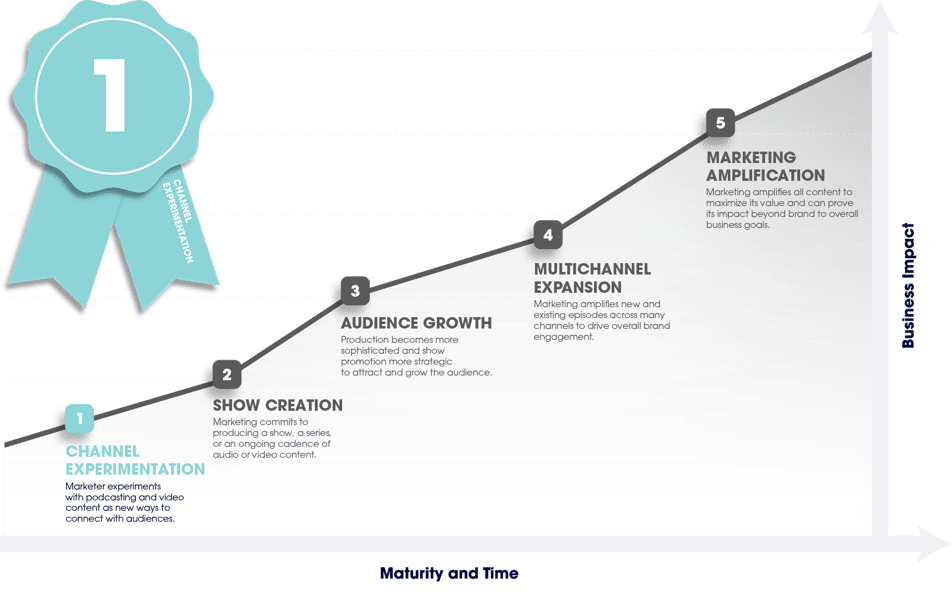
When you’re at Stage 1, maybe you listen to general consumer or B2B podcasts, watch webinars or virtual event content on demand, and want to give it a try, too. If you work on a small marketing team, you may think you don’t have the bandwidth to do a whole show, but maybe you want to try an experimental episode or two. Or maybe if you’re part of a large team or an enterprise business, someone in the company may have dabbled with podcasting or video projects before.
In Stage 1, someone at the company experiments informally with podcasting or video content. It’s simply a fun and creative experiment with low to no expectations about its performance. It’s something that a marketer or an executive is personally excited to try in hopes of turning an idea into a creative and tangible source of content.
Stage 1 Profile
-
- Team: 1-2 people lead the initiative.
- # of episodes: 0-12 episodes in market.
- Role in marketing strategy: Isolated experiment or side project.
- Measuring: Creative freedom.
- Publishing cadence: Sporadic.
Commitment: No company investment or commitment yet, as expectations are very low.
Outcome: The idea of creating a podcast becomes tangible.
Casted Customers: To illustrate how a brand develops a podcast at this stage, let’s look at how Dave Gerhardt created his first podcast as the former VP of Marketing at Drift, a pioneer in conversational marketing and sales. As the brand’s first and only marketer, Gerhardt needed to create thought leadership content, and that meant finding an expert who could provide insights. Instead of looking outside the company, Gerhardt got an idea: What if he just talked with Drift’s founder David Cancel? And instead of trying to do this in an email chain, a DM thread, or even typing notes, Gerhardt simply asked Cancel to let him record a conversation between the two, which is often the first step in an amplified marketing journey.
“When I went to Drift, I had a really cool opportunity to work with David Cancel, and I was the first marketing person at Drift, and I just needed to get marketing content out of him. And so I just started interviewing him with my podcast gear that I had, and I was just going to ghost write for him and that transformed into us... He wasn't very good at just being interviewed and then just having to talk for 30 minutes… I had to do an interview back and forth with him to get more stuff out of him, and that morphed into this really cool conversation about these two people at completely different ends of their spectrum. And from a career, you have this proven CEO and this like no name, up-and-coming marketing person. And we ended up turning [it] into a podcast called Seeking Wisdom. And so really quickly over the course of a year and a half, I had launched three podcasts, and now it's just become like a pillar of anything that I do in marketing,” says Dave Gerhardt, former VP of Marketing at Drift.
That’s how Drift’s popular Seeking Wisdom podcast was born, and since then, the brand’s gone on to really leverage the power of podcasting — but it all started with an experiment.
Stage 2 — Show Creation
At Stage 2, the marketing team has completed its research into the channel and commits to producing a show, a series, or an ongoing cadence of audio or video content, which is mostly separate from other marketing initiatives. Inexpensive tools and modes of distribution are preferred, and initial metrics are basic downloads and the number of episodes published.
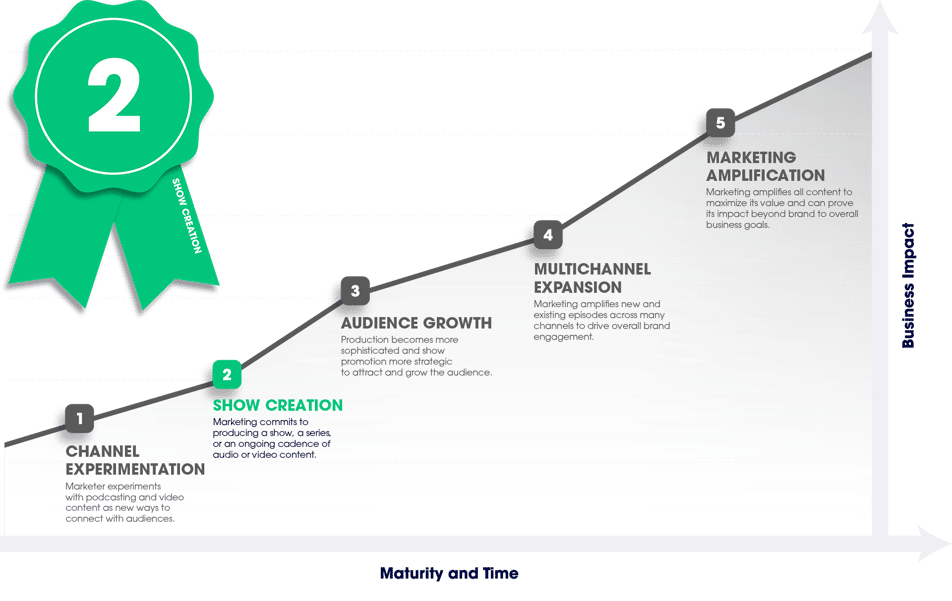 Stage 2 Profile
Stage 2 Profile
-
- Team: 1-2 marketers and/or executive host, might hire a freelance sound engineer.
- # of episodes: 1 show with 1-50 episodes.
- Role in marketing strategy: An early marketing project, perhaps approved as a test or cheap side project.
- Measuring: Downloads and number of episodes created and published.
- Publishing cadence: Ongoing show.
Commitment: Limited resources become available, but expected outcomes are still low.
Outcome to Move to Stage 3: A show is born.
Casted Customer Stories: After brands launch a podcast and nail down the production process in Stage 2, attention turns to expanding the audience — and making the show even more valuable to that audience.
With more than 25 shows broadcast worldwide, Salesforce uses their podcasts to build strong connections with their audiences. But back in 2015 when the brand launched its first podcast, the Marketing Cloudcast, Heike Young, Salesforce Content Innovation Lead at the time, had zero podcasting experience. That didn’t diminish her interest in experimenting with the format (Stage 1).
Initially, the brand had limited resources and had to use them intentionally to achieve the highest possible returns. Once the Marketing Cloudcast was up and running (along with all the shows that followed), Salesforce continued to evaluate who their audiences are for each show and what each show’s value should be.
The way Salesforce determined that value was by having conversations with experts that listeners were truly interested in and about the topics relevant to that audience. That’s how you define the value you can give your listeners. And that’s just what Salesforce did with their Marketing Cloudcast. Over 100 episodes later and with new hosts Tina Rozul and Megan Collins, the show still revolves around its audience.
Conor Wiegmann, Data Strategy Analyst, Strategic Solutions at Salesforce reinforces the focus on audience, “I've been on both sides of non-corporate podcasting and then corporate podcasting. So one thing that I would just suggest that I feel like Megan and Tina do a really good job of is understanding the value to the listener. There is the value to the company, but you also have to provide value to the listener. The Marketing Cloudcast, one thing that I've noticed is we rarely mentioned Salesforce products. And even though it is a Salesforce-sponsored podcast, the biggest point of value for our listener is that they're hearing practitioners or people in their role… So, I would definitely take a look at what's the value, yes, to your company? Because obviously that's how you're going to keep the podcast running. But what's the value to the listener as well?”
Director of Product Marketing at Salesforce and one of the hosts of the Marketing Cloudcast, Tina Rozul advises, “But it's just, again, being very intentional, right? So what is it that you want to achieve? What's the goal? Is it [that] you want to increase ROI? Well, you jumped a couple of steps because you have to build your listenership, you need to build trust. And you have to really, at the end of the day, share some topic or conversation that is of value to your listeners.”
For Salesforce to pull off a series of highly engaging podcasts, they stopped doing business as usual and listened to their fanbase. That’s what allowed them to create content that really resonated with real people looking for just this kind of connection.
Stage 3 — Audience Growth
Stage 3 brands have established their podcasts or video series, and they begin to gain traction. So this stage becomes acutely focused on growing the audience. To do that, marketing gets more intentional and strategic about promoting every episode — typically through email and social media. Curiosity rapidly arises about how to grow and further engage the audience to make the show a real success. Additionally, at this point, production tends to become more sophisticated to improve the quality of each episode.
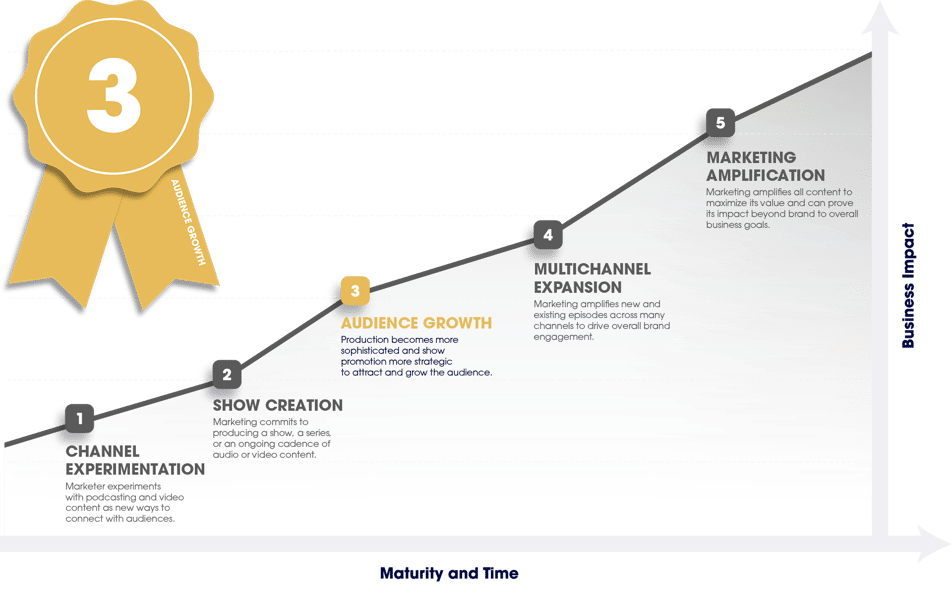 Stage 3 Profile
Stage 3 Profile
-
- Team: 2-5 marketers, an executive host, maybe a freelance audio engineer or a podcast production agency.
- # of episodes: 1-2 shows with 1-2 seasons each.
- Role in marketing strategy: A creative content program.
- Measuring: Audience growth and loyalty.
- Publishing cadence: Ongoing show(s). Typically weekly or bi-weekly.
Commitment: To increase or even retain the budget, marketing must grow and understand the audience.
Outcome to Move to Stage 4: Expand reach to establish a loyal and growing audience.
Casted Customer Stories:
Auth0: This SaaS brand provides customer identity access in their platform, specializing in authentication and authorization in data security. Proving their expertise in this area, Auth0 has created two podcasts: Authorization in Software (1 season, 8 episodes) and Identity Unlocked (4 seasons, 22 episodes), and they leverage these thought leadership shows to grow their audience and drive business results.
Drift: This well-established SaaS company, specializing in conversational marketing and sales technology, has created multiple shows, including Revenue Talks with Justin Keller and Katie Foote (1 season, 7 episodes), Conversation Starters with Sammi Reinstein (2 seasons, 17 episodes), Operations with Sean Lane (1 season, 86 episodes), American Dream with Elias Torres (1 season, 29 episodes), Growth with Matt Bilotti (1 season, 90 episodes), and Seeking Wisdom with David Cancel (2 seasons, 178 brief episodes). Drift has sunsetted some of their earlier podcasts, but each show continues to drive value, nonetheless. Now Drift is focused on expanding their audience and have begun to wring out content and embed clips.
IBM: As a longtime technology brand, IBM recognizes the importance of expanding into the channels where their audiences are. That’s why they have many podcasts designed to engage each segment of their audience, from The Art of Automation (2 seasons, 36 episodes) and Think Blockchain (1 season, 7 episodes) to the IBM Developer Podcast (1 season, 65 episodes) and the IBM Cloud Podcast (1 season, 78 episodes). IBM leverages each of these content sources to grow their listenership.
Lumavate: This digital personalization SaaS company produces one show, Real Marketers, but they have over 100 episodes and have consistently grown their listenership. Lumavate also wrings out their content to promote through social media, newsletters, presentations, and other marketing materials.
Flip CX (formerly RedRoute): This SaaS brand offers voice AI and intelligent inbound call routing, and they launched their show, Spamming Zero (1 season, 11 episodes), to promote brand awareness and thought leadership. Now Flip CX is focusing on building their audience and promoting their podcast.
Salesforce: This massive cloud-based CRM brand has been stellar in their ability to launch more than 30 shows and grow their audiences for each, including Blazing Trails (6 seasons, 199 episodes), The Marketing Cloudcast (5 seasons, 115 episodes), and Salesforce Spotlight Series (1 season, 11 episodes). With a global podcast footprint and a solid reach into Europe and APAC, Salesforce will continue to leverage its podcasts as a great source of content that they can wring out and connect with all of their different audiences.
Stirista: As a data-driven marketing agency offering custom audience segments and marketing campaigns, Stirista has steadily been growing the audience of their show, The Marketing Stir (140 episodes). They’ve begun wringing out content and are exploring the best ways to prove how their show impacts their funnel, which will help Stirista estimate ROI.
Stage 4 — Multichannel Expansion
At this level, marketing begins to think beyond the show. While Stage 3 was focused on building an audience for the podcast, Stage 4 is all about using the show to build the brand. Marketing increases the value of every podcast and video by wringing out new and existing episodes and amplifying them across many channels to drive overall brand engagement. By repurposing content into clips, embeds, transcripts, audiograms, videograms, and more, the brand builds a community, and the show fuels content strategy.
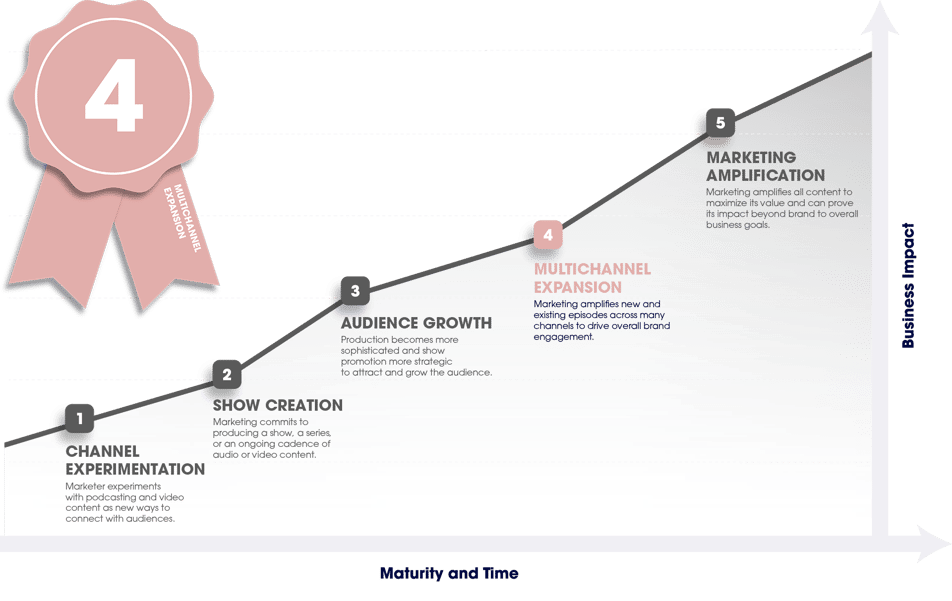 Stage 4 Profile
Stage 4 Profile
-
- Team: 2-10 marketers, executive host, maybe a podcast agency, and the content may be used by other departments.
- # of episodes: Multiple shows, many episodes, and many different content formats (internal, external, networks, etc.).
- Role in marketing strategy: Important to content strategy.
- Measuring: Engagement across various channels, WHO is in the audience, and the impact on the funnel.
- Publishing cadence: Ongoing show(s).
Commitment: Budget is solid but won’t be increased until business value is proven.
Outcome to Move to Stage 5: Amplify engagement across channels.
Casted Customer Stories:
Caterpillar: Founded in 1925, this well-known manufacturing brand started podcasting in 2018. They now have the show Cat Power (19 episodes) and have steadily expanded their audience and achieved brand awareness among the next generation of customers. Now Caterpillar’s wringing out content in various ways like creating audio- and videograms, embedding clips, and amplifying their content through social media, newsletters, etc.
Gong: This SaaS brand excels in capturing and analyzing customer interactions to provide marketing insights. They produce two shows: Reveal: The Revenue Intelligence Podcast (153 episodes) and Gong Labs Live (1 season, 11 episodes). Gong also embeds short bite-sized clips in blogs, social, and email. In the past, they’ve turned a live event into their podcast Reveal, and they continue to move toward amplifying all of their valuable content to drive their overall marketing strategy.
OpenView: OpenView, a leading venture capital firm focused on business software, produces the Build with Blake Bartlett podcast (11 seasons, 193 episodes), and they’re cutting up their episodes into clips and embedding them in blogs and social media. OpenView also leverages Themes and Insights analytics. They are masters of wringing out their content and are moving toward being able to attribute how their podcast and amplified marketing strategy are impacting the business.
Planful: This SaaS company has a cloud-based continuous planning platform focused on Finance Professionals and Accountants. To expand their reach, Planful created the Being Planful podcast (1 season, 33 episodes) which delves into topics their audience is most interested in. Planful also put on a virtual event in 2021 where each of its 37 speaker sessions were converted to on-demand video and podcast content within 24 hours. The brand continues to move up the B2B Podcast Maturity Curve by embedding clips to amplify their content across channels and attract customers.
Stage 5 — Marketing Amplification
The hallmark of Stage 5 is clear, measurable business value. At this level, podcast and video content are central to a brand’s overall marketing strategy. Marketing amplifies all content to maximize its value and can prove its impact — beyond brand awareness — on overall business goals and revenue.
Here brands optimize a mix of new and existing content and amplify it across multiple channels to drive engagement and revenue. While marketing owns amplification, the strategy also benefits customer success, sales, leadership, and more.
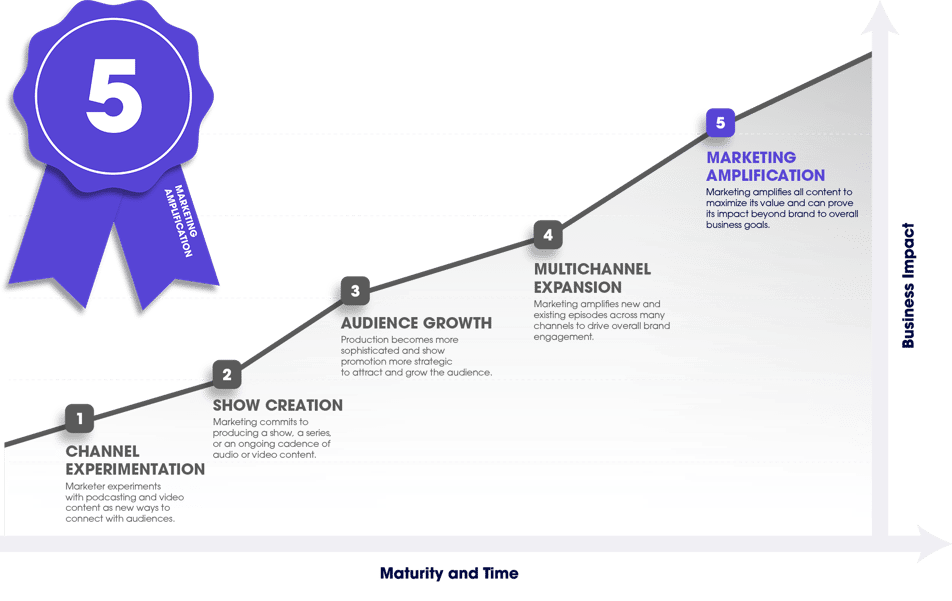 Stage 5 Profile
Stage 5 Profile
-
- Team: 2-10 marketers, host, maybe a podcast agency, and may be used by other departments. Also, executive buy-in.
- # of episodes: Many. Audio and video content are central to content marketing.
- Overall place in marketing strategy: Foundational to an integrated marketing strategy.
- Measuring: Influence on brand growth and ultimately impact on revenue.
- Publishing cadence: Ongoing show(s).
Commitment: Resources are made available, and funding is secure and likely to expand.
Expected Outcome to Complete Stage 5: Business value is clear and measurable, and content is deployed to amplify revenue, pipeline, and leads.
Casted Customer Stories:
Cheetah Digital: Experts in B2B and B2C customer loyalty, Cheetah Digital’s content strategy is video-first, and they leverage several shows, including Thinking Caps (90 episodes), Signals (99 episodes), and Uncaged Wisdom (55 episodes) to expand their customer reach and serve as source content that can be cut up into clips and embedded in social media, newsletters, email, blogs, and more. At the top of the Maturity Curve, Cheetah is identifying and measuring how their content marketing truly impacts the business and drives revenue better than most other brands.
Zylo: As a SaaS Management and Optimization platform, Zylo produces the SaaSMe Unfiltered podcast (1 season, 4 episodes) and leverages the show content in conjunction with Zylo webinars, short FAQ videos, and even their own SaaSMe event, which is a great source of content by itself. They have expanded into various channels and are wringing out their content by embedding clips to amplify and promote the brand’s thought leadership. Today, Zylo is looking at the big picture of how their content impacts revenue and how engagement insights help make it a predictable and repeatable part of content marketing.
Conclusion
Podcast and video content might seem daunting — whether you’re a small business or a global enterprise. That’s because B2B Marketing is at the beginning of a major evolution. We’re shifting from a playbook based entirely on written content to a playlist crafted around rich audio and video media.
We hope that the B2B Podcast Maturity Curve helps you see that you’re not alone on your journey. Even when it seems like some brands have it all figured out, everyone starts small and learns as they grow. Remember, don’t compare your beginning to someone else’s middle. What’s important is that you just get started — and that you understand what’s possible as you grow.
We’re still very early in the market’s adoption of this new and inevitable approach to B2B marketing. That means you still have an incredible opportunity to be ahead of the curve. So start today. A few stages down the road, and you (and your business) will be very glad you did.
Take our brand new 5-minute assessment, which will reveal how mature your podcast and video strategy is and what you can do to make it even more powerful and valuable.





